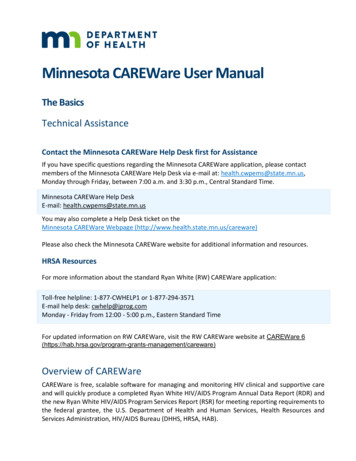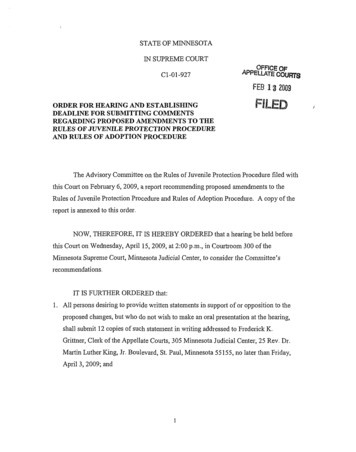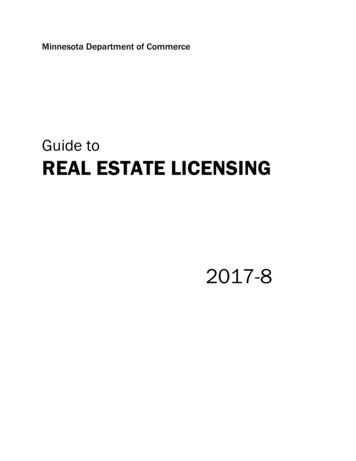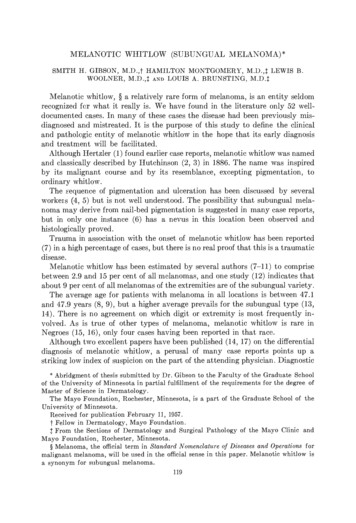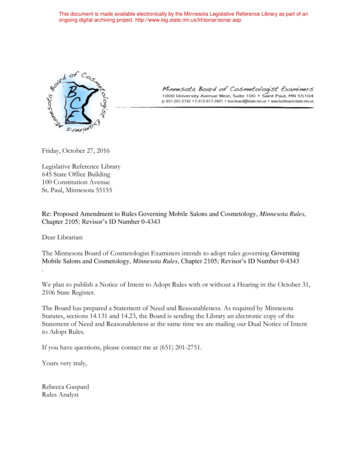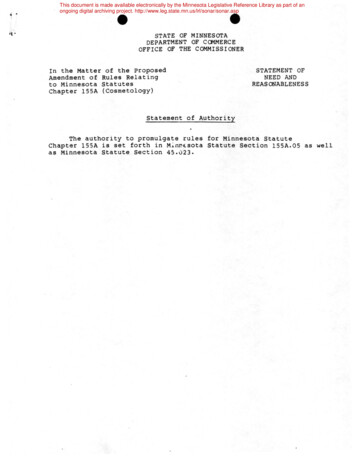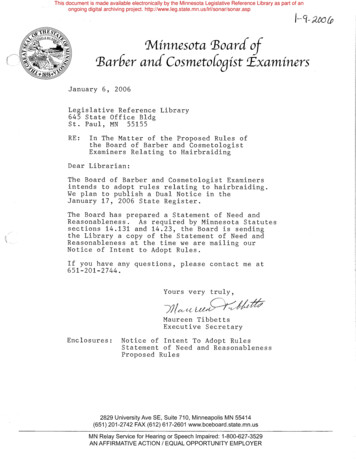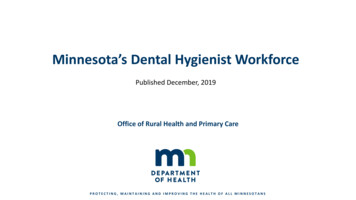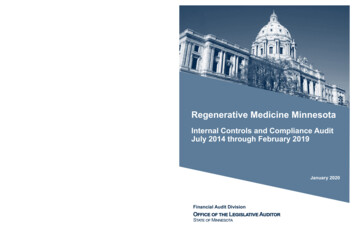
Transcription
Regenerative Medicine MinnesotaInternal Controls and Compliance AuditJuly 2014 through February 2019January 2020Financial Audit DivisionOffice of the Legislative AuditorState of Minnesota
Financial Audit DivisionThe Financial Audit Division conducts 40 to 50audits each year, focusing on government entitiesin the executive and judicial branches of stategovernment. In addition, the divisionperiodically audits metropolitan agencies, several“semi-state” organizations, and state-fundedhigher education institutions. Overall, thedivision has jurisdiction to audit approximately180 departments, agencies, and otherorganizations.Policymakers, bond rating agencies, and otherdecision makers need accurate and trustworthyfinancial information. To fulfill this need, theFinancial Audit Division allocates a significantportion of its resources to conduct financialstatement audits. These required audits includean annual audit of the State of Minnesota’sfinancial statements and an annual audit of majorfederal program expenditures. The division alsoconducts annual financial statement audits of thethree public pension systems. The primaryobjective of financial statement audits is toassess whether public financial reports are fairlypresented.The Office of the Legislative Auditor (OLA) alsohas a Program Evaluation Division. The ProgramEvaluation Division’s mission is to determine thedegree to which state agencies and programs areaccomplishing their goals and objectives andutilizing resources efficiently.OLA also conducts special reviews in response toallegations and other concerns brought to theattention of the Legislative Auditor. TheLegislative Auditor conducts a preliminaryassessment in response to each request for aspecial review and decides what additional actionwill be taken by OLA.For more information about OLA and to accessits reports, go to: www.auditor.leg.state.mn.us.The Financial Audit Division conducts somediscretionary audits; selected to provide timelyand useful information to policymakers.Discretionary audits may focus on entiregovernment entities, or on certain programsmanaged by those entities. Input frompolicymakers is the driving factor in the selectionof discretionary audits.Photo provided by the Minnesota Department of Administration with recolorization done by 5811929076/in/album-72157663671520964/)Creative Commons License: ode
OFFICE OF THE LEGISLATIVE AUDITORSTATE OF MINNESOTA James Nobles, Legislative AuditorJanuary 2020MembersLegislative Audit CommissionMembersRegenerative Medicine Minnesota BoardMembersUniversity of Minnesota Board of RegentsThis report presents the results of our internal controls and compliance audit of RegenerativeMedicine Minnesota for the period July 2014 through February 2019. The objectives of this auditwere to determine if Regenerative Medicine Minnesota had adequate internal controls over selectedfinancial activities and complied with significant finance-related legal requirements.Regenerative Medicine Minnesota does not agree with all findings as stated in their response onpage 23. We have considered all additional information presented by Regenerative MedicineMinnesota and the University of Minnesota and believe the evidence we obtained and the testing weperformed during the course of the audit supports our conclusions.This audit was conducted by Lori Leysen (Audit Director), Heather Rodriguez (Audit Coordinator),Tracia Polden (Senior Auditor), and Paul Rehschuh (Senior Auditor).Regenerative Medicine Minnesota is a partnership between the University of Minnesota and theMayo Clinic. We received the full cooperation of the partnership entities while performing thisaudit.Sincerely,Lori Leysen, CPAAudit DirectorRoom 140 Centennial Building, 658 Cedar Street, St. Paul, Minnesota 55155-1603 Phone: 651-296-4708 Fax: 651-296-4712E-mail: legislative.auditor@state.mn.us Website: www.auditor.leg.state.mn.us Minnesota Relay: 1-800-627-3529 or 7-1-1
Table of ContentsPageReport Summary . 1Conclusions . 1Audit Overview. 3Regenerative Medicine Minnesota Overview . 3Audit Scope, Objectives, Methodology, and Criteria . 5Grant Proposal Evaluation and Awarding . 7Grant Award Categories . 7Preventing Conflicts of Interest . 10Equitable Proposal Evaluation . 11Awarding Projects . 11Grant Award Oversight . 15Monitoring Financial Activities . 15Monitoring Project Deliverables . 16List of Recommendations . 19Appendix: 2014 Appropriation Law . 21Agency Response .23
Internal Controls and Compliance Audit1Report SummaryRegenerative medicine assists the body’s own ability to heal. Cell and developmentalbiology, regenerative pharmacology and immunology, medicine and surgery,biotechnology, bioengineering, and other relevant fields, are brought together todevelop ways to replace, restore, or regenerate damaged or malfunctioning cells,tissues, and organs to help people return to better health.The 2014 Legislature provided funding to the University of Minnesota to bringMinnesota to the forefront of regenerative medicine. The Legislature provided 4.5 million in Fiscal Year 2015 and 4.35 million in subsequent fiscal years toestablish a “collaborative partnership between the University of Minnesota and theMayo Clinic for regenerative medicine research, clinical translation, andcommercialization.”1 This partnership is now referred to as Regenerative MedicineMinnesota (RMM).RMM partners created an advisory board to help oversee the program. This five-personboard includes two individuals that are not affiliated with the University of Minnesotaor the Mayo Clinic. Representatives from the University of Minnesota and the MayoClinic serve as co-chairs of the board.RMM partners use their funding primarily to issue grants. The partners awarded 125grants, totaling 17.44 million, from the inception of the program through the end ofour audit scope, February 2019.The Office of the Legislative Auditor (OLA) conducted this audit in response toallegations of mismanagement within the RMM partnership. OLA scoped its work todetermine whether RMM had adequate internal controls and complied with financerelated legal requirements. The period under examination went from July 2014 throughFebruary 2019.ConclusionsInternal ControlsOLA found that internal controls over the areas in our audit scope were generally notadequate to safeguard assets and ensure compliance with applicable legal requirements.Internal ControlsNotAdequate1Generally NotAdequateGenerallyAdequateLaws of Minnesota 2014, chapter 312, art. 1, sec. 4, subd. 2.Adequate
2Regenerative Medicine MinnesotaSpecifically, this audit identified internal control weaknesses related to proposalevaluations, project awards, and grant project oversight. Finding 2. One proposal evaluator had a conflict of interest. (p. 10) Finding 3. Grant proposals did not always receive an equal level of scrutiny.(p. 11) Finding 4. Administrative errors resulted in inappropriate grant fundingdecisions. (p. 12) Finding 5. Some grant contracts had inconsistent terms. (p. 13) Finding 6. Grant reimbursement requests lacked sufficient documentation tojustify costs and, in one case, included unallowable costs. (p. 15) Finding 7. The Regenerative Medicine Minnesota Board does not review allproject deliverable reports. (p. 17)Legal ComplianceThe RMM partners generally did not comply with finance-related legal requirements.Legal ComplianceDid NotComplyGenerally DidNot ComplyGenerallyCompliedCompliedOLA found that RMM provided accurate information in its biennial reports to theLegislature. However, RMM awarded 58 grants that were not authorized in state law.We also found one instance where grant evaluators did not comply with RMM’sconflict of interest policies. Finally, our audit found instances where grant proposalsreceived unequal scrutiny due to noncompliance with RMM’s proposal scoringmethodology. Finding 1. RMM spent some of its state appropriation on grants the stateappropriation law did not authorize. (p. 9) Finding 2. One proposal evaluator had a conflict of interest. (p. 10) Finding 3. Grant proposals did not always receive an equal level of scrutiny.(p. 11)
Internal Controls and Compliance Audit3Audit OverviewThis report presents the results of aninternal controls and compliance audit ofselected activities of RegenerativeMedicine Minnesota (RMM), apartnership between the University ofMinnesota and the Mayo Clinic.Management is responsible forestablishing internal controls to safeguardassets and ensure compliance withapplicable laws, regulations, and tA strong system of internal controlsInformation andControlCommunicationActivitiesbegins with management’s philosophy,operating style, and commitment to ethicalvalues. It also includes processes tocontinuously assess risks and implement control activities to mitigate risks. Asuccessful internal controls system includes iterative processes to monitor andcommunicate the effectiveness of control activities.Regenerative Medicine Minnesota OverviewRegenerative Medicine Minnesota is a partnership between the University of Minnesotaand the Mayo Clinic. The 2014 Legislature mandated that this partnership also include“representatives of private industry and others with expertise in regenerative medicineresearch, clinical translation, commercialization, and medical venture financing.”2 TheLegislature stipulated that these additional representatives cannot be affiliated witheither the University of Minnesota or the Mayo Clinic.RMM created an oversight board in response to the legislative governance mandate.The dean of the University of Minnesota’s Medical School and the director of the MayoClinic’s Center for Regenerative Medicine serve as co-chairs of the board. Thepartnership also includes three other oversight board members, as depicted in Exhibit 1.2Laws of Minnesota 2014, chapter 312, art. 1, sec. 4, subd. 2.
4Regenerative Medicine MinnesotaExhibit 1: Regenerative Medicine Minnesota BoardDr. Jakub TolarDr. Andre TerzicUniversity of Minnesota(Co-Chair)Mayo Clinic(Co-Chair)Margaret AndersonKelliherRoberta KingVen MandaBe the MatchMedtronicDepartment ofTransportationSOURCE: Regenerative Medicine Minnesota website (November 2019).The 2014 Legislature provided ongoing basefunding for the RMM partnership from thestate’s General Fund for three purposes:1.2.3Regenerative medicine researchClinical translationCommercialization3Funding for the RegenerativeMedicine Minnesota partnershipcomes from the General Fund, with basefunding set at 4.35 million annually.Funding for the partnership does nothave any sunset provision in law.The legislation prohibits the University of Minnesota from using any funds appropriatedto RMM for administrative or monitoring expenses. RMM uses its funding primarily tomake grants. Exhibit 2 illustrates the grants that were awarded by the partnership fromthe inception of the program through March 2019. The University recorded projectexpenditures under the fiscal year the board funded the project.University staff help carry out grant administration and oversight functions, and theUniversity absorbs these costs. The University also pays for grant proposal evaluatorsand biennial audits, which are required by the 2014 legislation. Finally, the Universityand the Mayo Clinic alternate hosting and paying for an annual celebration (a gatheringof current and former awardees and interested legislators). Outside of grant activity, theonly expense paid with the partnership’s base funding is the development andmaintenance of the RMM website, which totaled 155,466 from July 2014 throughMarch 2019.3Laws of Minnesota 2014, chapter 312, art.1, sec. 4, subd. 2. A copy of the law is in the Appendix.
Internal Controls and Compliance Audit5Exhibit 2: Regenerative Medicine Minnesota Grant Activity,July 2014 through March 2019 (in thousands)Grants Awarded2015 4,421Fiscal Year20162017 3,746 4,4692018 4,801Grant Expenditures by CategoryResearchBiobusiness DevelopmentEducationClinical CareTotal Expenditures 2,9636957003 4,361 2,2594467140 3,419 2,1908814820 3,553 1,1753282260 1,729Unspent Awardsa 327 916 3,07260NOTES: This exhibit includes expenditure information through March 2019; however, the scope of the audit went throughFebruary 2019. RMM made additional research grant awards in January and April 2019, which OLA did not include becausethe grant periods started after the end of the audit scope.aUnused funding from each year is available to be awarded in future years.SOURCE: Office of the Legislative Auditor, summary of University of Minnesota data.Legislation requires the partnership to obtain a biennial financial audit. The results ofthe audit, as well as the names of award recipients and any affiliation with theUniversity or the Mayo Clinic, must be submitted to the legislative committeesoverseeing higher education and economic development. The University submittedboth the audit and accompanying affiliation reports in January 2017 and January 2019.OLA compared the information submitted to the Legislature in the mandated reports tothe partnership’s award records and concluded that the reports were materially accurate.Audit Scope, Objectives, Methodology, and CriteriaGrant Proposal Evaluation and AwardingThis part of the audit focused on the processes for evaluating grant proposals andselecting projects to fund. OLA designed its work to address the following questions: Did RMM develop adequate controls to objectively evaluate proposals andaward grants? Did RMM evaluate proposals against its established criteria and fund the topscoring projects?To answer these questions, OLA held discussions with the partnership co-chairs andstaff from the University to gain an understanding of controls over grant projectselection and awards. OLA randomly selected two of the five years in the audit scopeand tested project selection and award controls during those periods.
6Regenerative Medicine MinnesotaGrant Award OversightThis part of the audit assessed the partnership’s monitoring of grant projects. OLAdesigned its work to address the following questions: Did RMM develop adequate controls to ensure that funded projects metdeliverables and expected outcomes? Did the RMM partnership only reimburse allowable project costs?To answer these questions, OLA held discussions with the partnership co-chairs andstaff from the University to gain an understanding of project monitoring controls. Werandomly selected 16 of 124 awards for detailed testing, which included 6 University ofMinnesota awards, 4 Mayo Clinic awards, and 6 awards to other institutions.4 Ourtesting methodology included a review of grant recipient reporting, payrollexpenditures, nonpayroll expenditures, and indirect costs.We conducted this performance audit in accordance with generally acceptedgovernment auditing standards.5 Those standards require that we plan and perform theaudit to obtain sufficient, appropriate evidence to provide a reasonable basis for ourfindings and conclusions based on our audit objectives. We believe that the evidenceobtained provides a reasonable basis for our findings and conclusions based on ouraudit objectives.We assessed internal controls against the most recent edition of the internal controlstandards, published by the U.S. Government Accountability Office.6 While theUniversity follows the internal control standards published by the Committee ofSponsoring Organizations (COSO), both frameworks describe internal controls througha relatively identical hierarchical structure of five components and seventeenprinciples.7To identify legal compliance criteria, we examined RMM’s enabling legislation. OLAalso reviewed internal policies and standards, promulgated by the University ofMinnesota, and grant issuance guidelines approved by the board. Finally, we reviewedcertain grant policies from the National Institutes of Health.4There were 125 awards in the audit scope; however, we excluded a clinical care award because it was theonly award made in that category.5Comptroller General of the United States, Government Accountability Office, Government AuditingStandards (Washington, DC, December 2011).6Comptroller General of the United States, Government Accountability Office, Standards for InternalControl in the Federal Government (Washington, DC, September 2014).7University of Minnesota Board of Regents Administrative Policy, Internal Control.
Internal Controls and Compliance Audit7Grant Proposal Evaluation andAwardingThe Regenerative Medicine Minnesota (RMM) partners are responsible for establishingcontrols to solicit, review, and approve grants. Some of the most important controlsthat OLA identified include: Detailed instructions for grantees, with specific grant categories. Grant evaluator conflict of interest guidelines. Adoption of the National Institutes of Health’s nine-point scoring system forproposal evaluations.8We reviewed the proposal evaluation and awarding process for two of the five fiscalyears in our audit scope to assess the effectiveness of internal controls.Grant Award CategoriesLegislation requires RMM to use its funds for “regenerative medicine research, clinicaltranslation, and commercialization.”9 Since the law did not define these terms, we usedguidance from the National Institutes of Health, the framework used by the partnership,to arrive at more granular definitions, depicted in Exhibit 3.Exhibit 3: National Institutes of Health DefinitionsResearchTranslationSystematic study directedtoward fuller scientificknowledge or understanding ofthe subject studiedApplying discoveries generatedduring research in the laboratoryand in preclinical studies to thedevelopment of trials and studies inhumansResearch aimed at enhancing theadoption of best practices in thecommunityCommercializationDeveloping products, processes,technologies, or servicesProduction and delivery of theproducts, processes,technologies, or services for saleto use by commercial marketsCost-effectiveness of preventionand treatment strategiesSOURCE: National Institutes of Health, glossary of terms.8National Institutes of Health, Scoring System and Procedure (March 2015), https://grants.nih.gov/grants/peer/guidelines general/scoring system and procedure.pdf, accessed October 22, 2019.9Laws of Minnesota 2014, chapter 312, art. 1, sec. 4, subd. 2.
8Regenerative Medicine MinnesotaThe RMM partnership established four categories for grant awards and defined them asfollows: Research. Covers discovery science, translational research, and clinical trials. Education. Includes grants to improve knowledge, develop interest, and trainand retain students from kindergarten through post-doctoral programs. Biobusiness development. Includes grants to develop Minnesota businessesand technologies that deliver products, devices, and services. Clinical care. Includes grants to create and update access to regenerativemedicine for patients.Exhibit 4 shows the distribution of RMM grants in three of these categories.Exhibit 4: Percentage of RMM Grants by CategoryDollars AwardedResearch70%Biobusiness DevelopmentEducationNumber of Awards30%16% 23%14%46%NOTE: The data excludes one clinical care award, which represented 1 percent of total dollars awarded.SOURCE: Regenerative Medicine Minnesota award records.
Internal Controls and Compliance Audit9FINDING 1RMM spent some of its state appropriation on grants the stateappropriation law did not authorize.The 2014 law that created an annual appropriation to theUniversity established clear, unambiguous language forhow RMM may use the money. The law says:This appropriation is from the general fund for thedirect and indirect expenses of the collaborativepartnership between the University of Minnesotaand the Mayo Clinic for regenerative medicineresearch, clinical translation, andcommercialization.10 [Emphasis added.]52%of education awards werefor grades K-12In determining RMM’s compliance with this language, we followed the guidance ofMinnesota Statutes 2019, 645.16, which says, “When the words of a law in theirapplication to an existing situation are clear and free from all ambiguity, the letter of thelaw shall not be disregarded under the pretext of pursuing the spirit.”In applying this guidance, we concluded that RMM did not comply with the law when itawarded 58 educational grants during the period covered by our audit, totaling 2.46 million. We do not question the value of RMM’s education grants; we questionRMM’s authority to use money the Legislature has annually appropriated to RMM for apurpose not stated in the appropriation law.We specifically question RMM’s decision to make 30 education grants—totaling 441,000—to support programs and activities at the K-12 level of education.11 Thesegrants paid for programs and activities such as Scrubs Camps,12 Let’s Explore STEMCamps,13 and workbooks for grade school students. In making these grants, RMMdiverted state money from the purposes the Legislature stated in the RMMappropriation law.During our audit, RMM officials told us that the Legislature did not intend to limitRMM’s use of its state appropriation to the purposes listed in the appropriation law.Rather, they told us that the Legislature intended for the experts in regenerative10Laws of Minnesota 2014, chapter 312, art.1, sec. 4, subd. 2. A copy of the law is in the Appendix.11The other 28 education grants funded student scholarships and supported various other activities inseveral higher education institutions, including the University of Minnesota. RMM could havecategorized some of these grants as research, but we included all 28 grants in the 58 education grantsbecause that is how RMM categorized them.12Scrubs Camps provide K-12 students with information and experiences related to medical careersgenerally and not necessarily about careers in regenerative medicine.13STEM is the acronym for a curriculum concept to blend together the teaching of science, technology,engineering and mathematics. According to RMM’s website, its involvement in supporting STEM is tobuild networks and connections among underrepresented populations of youth, university and collegestudents, and industry members.
10Regenerative Medicine Minnesotamedicine at the University and Mayo Clinic to use their discretion and judgment indeciding how RMM should spend the state appropriation. The officials also said that invarious conversations, several legislators have supported RMM’s use of some of thestate appropriation for education grants.If RMM officials are correct, the appropriate action would be to ask the Legislature toamend the 2014 law to explicitly authorize RMM to make education grants and,specifically, education grants at the K-12 level of education.RECOMMENDATIONS Regenerative Medicine Minnesota should only issue grants for activitiesauthorized in law. Regenerative Medicine Minnesota partners should seek a law change ifthey want to continue awarding educational grants.Preventing Conflicts of InterestRMM partners established practices to identify and address potential conflicts ofinterest with grant proposal evaluators. The partnership has a pool of approximately120 individuals who serve as independent evaluators. These evaluators cannot work forthe University or the Mayo Clinic, and they must have subject matter expertise inregenerative medicine. Evaluators also must reside outside Minnesota, since grantapplicants must be based in the state.RMM partners assess evaluator independence on a proposal by proposal basis. Beforeassigning proposals, the partners send potential evaluators a list of grant applicants andproject personnel to identify potential conflicts.Overall, OLA found that the RMM partnership’s conflict of interest controls wereoperating effectively. However, we identified one conflict of interest issue during ourdetailed grant testing.FINDING 2One proposal evaluator had a conflict of interest.Six evaluators scored a group of biobusiness development proposals in 2016. One ofthese individuals was also a staff member on a funded proposal from that same categoryin 2016. The evaluator disclosed the conflict, and the RMM partners did not assign herto evaluate the proposal where she had a personal interest. However, she was stillpermitted to serve in an evaluator role for competing proposals in that same category.The objectivity of grant awards can be questioned if evaluators have any personalaffiliation with current or former RMM projects. The individual cited above evaluatedeight biobusiness proposals in 2016 and gave the lowest scores to five. Had this
Internal Controls and Compliance Audit11conflict been known by unsuccessful applicants, they could have challenged theintegrity of the entire pool of biobusiness grant awards in 2016.RECOMMENDATIONRegenerative Medicine Minnesota partners should not let evaluators scoreproposals if they have an affiliation with other competing projects.Equitable Proposal EvaluationHaving the same number of evaluations helps ensure that the partnership treats grantapplicants fairly, minimizing the risk of individual rater bias.FINDING 3Grant proposals did not always receive an equal level of scrutiny.During detailed testing of the evaluation process, OLA found that grant applications didnot always receive the same number of evaluations. For example, in Fiscal Year 2018,11 of the 34 discovery science research proposals had two evaluations while theremaining 23 proposals had three evaluations. It is difficult to assess the effect that athird reviewer may have had on the final score of each proposal. However, all six of thediscovery science research proposals funded in 2018 were from the group that only hadtwo evaluations. Given the unequal treatment, unsuccessful grantees could havechallenged the awards due to the potential bias in the scoring.RECOMMENDATIONRegenerative Medicine Minnesota partners should ensure that all grantproposals receive a consistent review.Awarding ProjectsThe RMM program administrator compiles all evaluator scores into a master list andworks with the University co-chair to determine which projects to recommend forfunding. The RMM Board establishes budgets for each award category, which theprogram administrator and University co-chair use to fund as many projects aspossible, based on their relative scores. The RMM Board reviews the scores andrecommendations before finalizing awards.The University and the Mayo Clinic have received the majority of the research andeducation awards, as depicted in Exhibit 5. Evaluators often rate their proposals thehighest, which we contribute, in part, to their existing infrastructure and resources.
12Regenerative Medicine MinnesotaExhibit 5: The University of Minnesota and Mayo Clinicreceived the majority of awards in two of three categoriesResearch21Education23Biobusiness Development61611248150%University of Minnesota100%Mayo ClinicOther ExternalNOTE: This exhibit excludes one clinical care award received by the Mayo Clinic.SOURCE: Regenerative Medicine Minnesota award records.FINDING 4Administrative errors resulted in inappropriate grant funding decisions.Our audit found errors in the process used to aggregate evaluator scores and make grantfunding decisions. Due to these errors, the RMM Board approved some grant projectsthat should not have been selected for funding. The RMM Board also disqualified someproposals that should have received funding.For example, in 2016 the program administrator used an incorrect formula to calculatethe final scores for the grant proposals. This error resulted in the Board erroneouslyfunding a 250,000 research proposal, thereby preventing funding of a competingproposal with higher evaluator scores. A similar situation occurred in 2018, leading theBoard to reject a 250,000 proposal that should have been funded.OLA identified other scoring-related errors as well. These errors included incompleteevaluations, evaluator scores that did not follow the National Institutes of Health’sguidelines, errors in the transferring of scores from evaluation forms to compilationspreadsheets, and calculation errors within the compilation spreadsheets.RECOMMENDATIONRegenerative Medicine Minnesota partners should conduct a comprehensivereview of the process used to compile grant proposal scores for decisionmaking.
Internal Controls and Compliance Audit13The University of Minnesota prepares formal grant contracts for award
RMM created an oversight board in response to the legislative governance mandate. The dean of the University of Minnesota’s Medical School and the director of the Mayo Clinic’s Center for Regenerative Medicine serve as co-chairs of the board. The partnership also includes three other oversight


